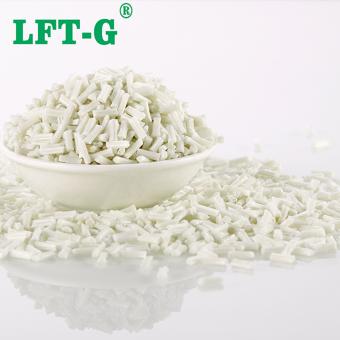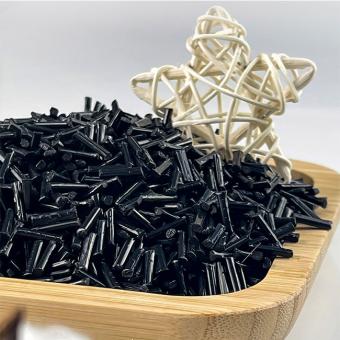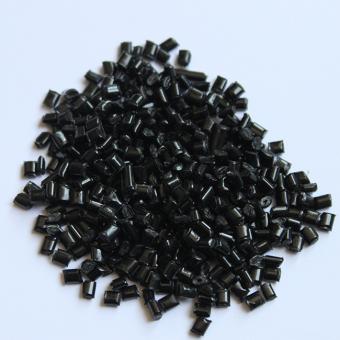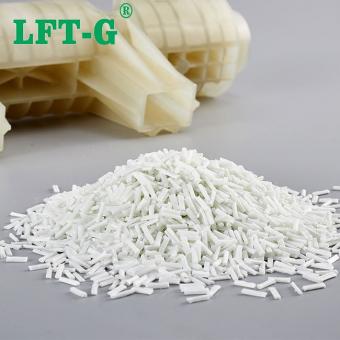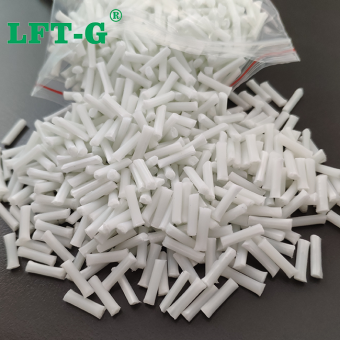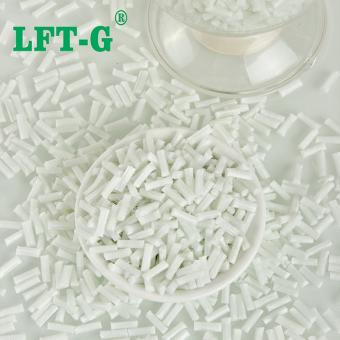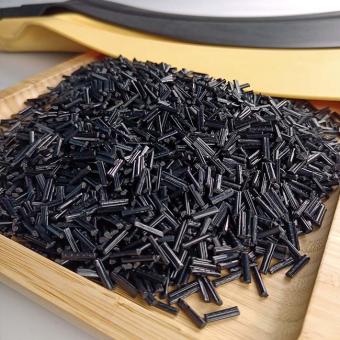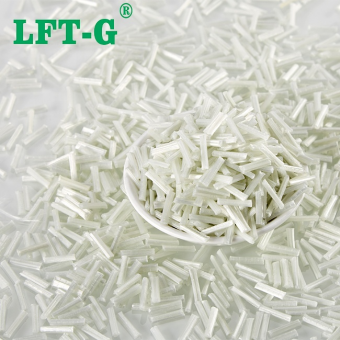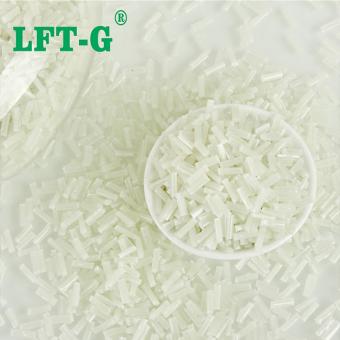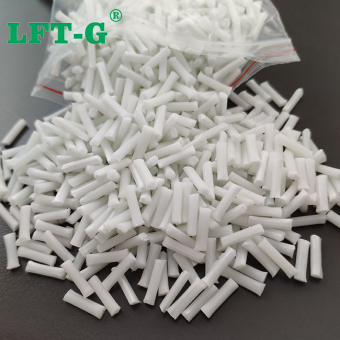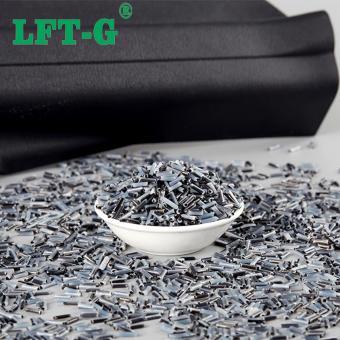-
Xiamen LFT MXD6 filling Long glass fiber30 high toughness injection molding natural color sample availableMXD6 Polyadipyl-m-benzoylamine, referred to as mxd6, generally referred to as "nylon mxd6", resin than other engineering plastics have higher mechanical strength and modulus, is also a special high barrier nylon material. Although the barrier of mxd6 is slightly worse than that of pvdc and evoh, its barrier is not affected by temperature and humidity, which is especially suitable for high temperature and humid occasions. In today's barrier packaging and plastic instead of steel general trend, nylon mxd6 has become one of the most eye-catching new plastic varieties. Structure performance: PA MXD6 nylon material has high strength, high rigidity, high thermal deformation temperature, small thermal expansion coefficient; Dimensional stability, low water absorption rate and small size change after water absorption, mechanical strength changes less; Forming shrinkage is small, suitable for precision forming processing; Excellent coating performance, especially suitable for high temperature surface coating; Excellent barrier to oxygen, carbon dioxide and other gases. Excellent mechanical and thermal properties and high strength, high modulus and heat resistance, high barrier, excellent cooking resistance Advantages 1、Maintain high strength and rigidity in a wide temperature range 2、High heat deflection temperature, small coefficient of thermal expansion 3、Low water absorption, small size change after water absorption, less mechanical strength reduction 4、Small shrinkage rate of molding, suitable for precision molding process 5、Excellent paintability, especially suitable for surface painting under high temperature 6、Excellent barrier to oxygen, carbon dioxide and other gases MXD6-LGF MXD6 applications in the plastics modification industry MXD6 can be compounded with glass fibers, carbon fibers, minerals and/or advanced fillers for materials containing 50-60% glass fiber reinforcement with exceptional strength and stiffness. Even when filled with high levels of glass fiber, its smooth, resin-rich surface creates a high gloss finish like no glass fiber, making it ideal for painting, metal coating or creating naturally reflective housings. 1、High fluidity for thin wall It is a very high flowing resin that can easily fill thin walls as thin as 0.5 mm thick even with glass fiber content as high as 60%. 2、Excellent surface finish The resin-rich perfect surface has a highly polished appearance, even with a high glass fiber content. 3、Very high strength and stiffness MXD6 with 50-60% glass fiber reinforcement has a tensile and flexural strength similar to many cast metals and alloys. 4、Good dimensional stability At ambient temperature, the coefficient of linear expansion (CLTE) of MXD6 glass fiber composite is similar to that of many cast metals and alloys. It is highly reproducible due to low shrinkage and the ability to maintain tight tolerances (length tolerances can be as low as ± 0.05% if properly formed). TDS for reference only Application MXD6 replaces metal to make high quality structural parts for automobiles, electronics and electrical appliances In automotive parts, many occasions require material products with high mechanical strength and good oil resistance, and can be used in the range of 120-160℃ for a long time. The glass fiber reinforced MXD6 has a heat resistance of up to 225℃ and a high strength retention rate at high temperature, which can be used for cylinder block, cylinder head, piston, synchronous gear of automobile engines, etc. MXD6/PPO alloy has the properties of high temperature resistance, high strength, oil resistance, wear resistance, good dimensional stability, etc. It can be used for vertical outer panels of automobile bodies, front and rear fenders, wheel covers and almost impossible to be stamped and formed by steel plates. curved parts and chassis of automobiles. About us
- long glass fiber MXD6
- long fibre reinforced thermoplastics
- long glass fiber reinforced plastics granules
- MXD6 LGF
- glass fiber reinforced plastics granules
- MXD6 compounds
Tags :
-
LFT-G PA6 LCF nylon6 filling long carbon fiber reinforced material high quality for manufacturing helmesPolyamide6 Nylon 6 (PA6) as a general engineering plastics, with light weight, wear resistance, corrosion resistance, good toughness and other characteristics, and as a common thermoplastic resin, its heating can be softened, cooling can be hardened, and can be repeatedly heated softening, cooling hardening, repeated processing characteristics. Long carbon fiber With high strength, high modulus, large specific surface area and aspect ratio, and high electrical conductivity, carbon fiber fabrics have superior mechanical properties compared to glass fiber and can provide maximum strength in the fiber direction. Carbon fiber reinforced composites are stronger than polymer matrix materials, while maintaining the advantage of light weight, and are gradually replacing traditional metal materials in the fields of electronic products, electric vehicles, medical devices, industrial equipment and sports and leisure products. LCF VS SCF Advantage of LCF (1) High strength and high toughness (2) Small coefficient of thermal expansion (3) Low hardness and light weight (4) Corrosion resistance and aging resistance (5) Temperature resistance TDS for reference Application Suitable for manufacturing helmets, car bumps and robotic arm etc. Certifications Injection molding Factory & Warehouse Teams & Customers About us Xiamen LFT composite plastic Co., Ltd is a brand-name company that focuses on LFT&LFRT. Long Glass Fiber Series (LGF) & Long Carbon Fiber Series (LCF). The company's thermoplastic LFT can be used for LFT-G injection molding and extrusion, and can also be used for LFT-D molding. It can be produced according to customer requirements: 5~25mm in length. The company's continuous infiltration reinforced thermoplastics have passed ISO9001&16949 system certification, and the products have obtained lots of national trademarks and patents.
- carbon fiber reinforced plastics granules
- long carbon fiber reinforced pa6
- long fiber compounds pa6
- long fiber composite pa6 granules
- long carbon fiber polyamide6
Tags :
-
LFT-G PA12 long carbon fiber compounds reinforced nylon12 high impact resistance for car partsLong carbon fiber Carbon fiber has many excellent properties, high axial strength and modulus, low density, high specific performance, no creep, super high temperature resistance in non-oxidizing environment, good fatigue resistance, specific heat and electrical conductivity between non-metal and metal, small coefficient of thermal expansion and anisotropy, good corrosion resistance, good X-ray transmission. Good electrical and thermal conductivity, good electromagnetic shielding, etc. Compared with traditional glass fiber, carbon fiber has more than 3 times of Young's modulus; it is about 2 times of Young's modulus compared with Kevlar fiber, which is insoluble and swollen in organic solvents, acids and alkalis, and has outstanding corrosion resistance. But is there a way to reduce the price of carbon fiber? That is to mix it with relatively cheap nylon material to form a composite material with good performance and meet the requirements. In that case, there is no doubt that carbon fiber nylon will definitely have a place in the composite material. Nylon itself is an engineering plastic with excellent performance, but moisture absorption, poor dimensional stability of products. Strength and hardness are also far from metal. In order to overcome these shortcomings, as early as before the 70s. People have used carbon fiber or other varieties of fibers for reinforcement to improve its performance. Carbon fiber reinforced nylon materials have developed rapidly in recent years, because nylon and carbon fiber are excellent performance in the field of engineering plastics materials, its compound material synthesis reflects the superiority of the two, such as strength and rigidity than unreinforced nylon is much higher, high temperature creep is small, thermal stability has improved significantly, good dimensional accuracy, wear resistance. Excellent damping, compared with glass fiber reinforced has better performance. Therefore, carbon fiber reinforced nylon (CF / PA) composites have developed rapidly in recent years. And for 3D printing using SLS technology is the most suitable technical means to achieve carbon fiber reinforced nylon. TDS for reference Application Our company Xiamen LFT composite plastic Co., Ltd is a brand-name company that focuses on LFT&LFRT. Long Glass Fiber Series (LGF) & Long Carbon Fiber Series (LCF). The company's thermoplastic LFT can be used for LFT-G injection molding and extrusion, and can also be used for LFT-D molding. It can be produced according to customer requirements: 5~25mm in length. The company's continuous infiltration reinforced thermoplastics have passed ISO9001&16949 system certification, and the products have obtained lots of national trademarks and patents.view more
-
LFT-G brand Polylactic Acid PLA green materials fill long glass fiber injection molding high performancePLA plastic Polylactic acid (PLA) is a kind of excellent biodegradable material, which is mainly produced from starch of renewable plant resources (e.g. corn, potato), and is widely used in the fields of packaging, agriculture, tableware, medical and daily non-woven materials due to its good processing properties, physical properties, mechanical properties, biocompatibility and biodegradability. The research on the preparation of multifunctional composite materials with PLA as the main matrix is the current hot spot in the development of degradable materials. Long glass fiber PLA can be processed in the same way as ordinary polymers, such as extrusion, cast molding, film blowing, injection molding, bottle blowing and fiber molding. The prepared films, sheets and fibers can be used in a wide range of applications such as garments, textiles, non-woven fabrics, packaging, agriculture, forestry, civil engineering and construction, medical and hygiene products, and daily necessities after secondary processing such as overheating and spinning. PLA products can be recycled by organic resources, physical recycling, landfill, thermal recycling or chemical recycling after use. Long glass fiber reinforced composites can solve your problems when other methods of reinforced plastics do not provide the performance you need or if you want to replace metal with plastic. Long glass fiber reinforced composites can cost effectively reduce the cost of goods and effectively improve the mechanical properties of engineering polymers, and increase the durability by forming long fibers to form a long-fiber-reinforced internal skeleton network. Performance is preserved in a wide range of environments. While bio-based polylactic acid (PLA) thermoplastics are relatively eco-friendly and easy to recycle, composite materials, such as fiberglass, are much stronger. Now, we can combine the benefits of both with new PLA composites. PLA-LGF display Product process Certifications Quality Management System ISO9001/1949 Certification National Laboratory Accreditation Certificate Modified Plastics Innovation Enterprise Honorary Certificate Heavy metal REACH & ROHS testing About us Xiamen LFT composite plastic Co., Ltd is a brand-name company that focuses on LFT&LFRT. Long Glass Fiber Series (LGF) & Long Carbon Fiber Series (LCF). The company's thermoplastic LFT can be used for LFT-G injection molding and extrusion, and can also be used for LFT-D molding. It can be produced according to customer requirements: 5~25mm in length. The company's continuous infiltration reinforced thermoplastics have passed ISO9001&16949 system certification, and the products have obtained lots of national trademarks and patents. Frequently asked questions Q. How to choose the reinforcement method and length of the material when using long fiber reinforced thermoplastic material? A. The selection of materials depend on the requirements of the products. It is necessary to access how much the content is enhanced and how much length is more appropriate, which are depending on the performance requirements of the products. Q. Under what circumstances can long fiber replace short fiber? What are the common alternative materials? A. Traditional staple fiber materials can be replaced with long glass fiber and long carbon fiber LFT materials in the case of customers whose mechanical properties cannot be met or where higher metal substitutes are desired. For example, PP long glass fiber is often replacing nylon reinforced glass fiber, and nylon long glass fiber is replacing PPS series. Q. Are there any special process requirements of long carbon fiber for the injection molding products? A. We must consider the requirements of long carbon fiber for the injection molding machine screw nozzle, mold structure and injection molding process. Long carbon fiber is a relatively high cost material, and need to evaluate the cost of performance problem in the selection process.
- long fiber compounds pla
- pla lgf30
- long fiber composite pla granules
- long glass fiber reinforced pla lft
- LFT composite
Tags :
-
LFT-G ABS Acrylonitrile Butadiene Styrene filling long glass fiber high performance for industrial useABS ABS resin is a thermoplastic polymeric structural material with high strength, good toughness and easy processing and molding. Long glass fiber reinforced ABS granules Long glass fiber reinforced plastic is based on the original pure plastic, adding long glass fiber and other additives, so as to improve the scope of use of the material. Generally speaking, most of the long glass fiber reinforced materials are mostly used in the structural parts of products, which is a structural engineering material, such as PP, ABS, PA66, PA6, PBT, PPS, etc. Advantages After long glass fiber reinforced, long glass fiber is a high temperature resistant material, therefore, the heat resistance temperature of reinforced plastics is much higher than before without long glass fiber. After long glass fiber reinforced, the addition of long glass fiber restricts the movement of polymer chains between plastics, so the shrinkage of reinforced plastics is much lower and the rigidity is much higher. After long glass fiber reinforcement, the reinforced plastic will not be stress cracked, and the impact resistance of the plastic will be improved. After long glass fiber reinforcement, long glass fiber is a high-strength material, which also greatly improves the strength of plastic, such as: tensile strength, compression strength, bending strength, much higher. After the long glass fiber reinforcement, the burning performance of the reinforced plastic decreases a lot due to the addition of long glass fiber and other additives, and most of the materials cannot be ignited, which is a kind of flame retardant material. Datasheet for reference Application Can be used at many fields. For more details, please contact us. Other products you may wonder PP-NA-LGF PA6-NA-LGF TPU-NA-LGF Frequently asked questions Q. What are the differences and advantages of long fiber materials and thermosets and staple fibers? A. Compared with the short fiber, it has more excellent performance in mechanical properties. It is more suitable for large products and structural parts. It has 1-3 times higher toughness than short fiber, and the tensile strength (strength and rigidity) is increased by 0.5-1 times. Compared with thermosets, it is more environmentally friendly. It can be recycled and reused, and has simple molding efficiency, lower cost etc. But its mechanical properties are worse than thermosets. Q. Using a long fiber reinforced thermoplastic material, will it block the die hole due to the long length of the fiber or not? A. When using long glass fiber or long carbon fiber, it is necessary to evaluate whether the product is suitable for LFT-G. If the product is too small or the dispensing is not suitable for long fiber materials. The long fiber itsalf has requirements for the mold nozzle. Q. How to choose the reinforcement method and length of the material when using long fiber reinforced thermoplastic material? A. The selection of materials depend on the requirements of the products. It is necessary to assess how much the content is reinforced and how much length is more appropreate, which are depending on the performance requirements of the products. Xiamen LFT composite plastic Co., Ltd. We will offer you 1. LFT & LFRT material technical parameters and leading edge design 2. Mold front design and recommendations 3. Provide technical support such as injection molding and extrusion moldingview more
-
LFT-G HDPE filling long glass fiber high toughness and stiffness modified plastic for shellHDPE Introduction High-density polyethylene is an opaque white waxy material, lighter than water, specific gravity of 0.941 ~ 0.960, soft and tough, but slightly harder than LDPE, but also slightly elongated, non-toxic, odorless. Flammable, can continue to burn after leaving the fire, the upper end of the flame is yellow, the lower end is blue, will melt when burning, there are liquid drops, no black smoke, at the same time, emitting the smell of paraffin wax when burning. Acid and alkali resistance, organic solvent resistance, excellent electrical insulation, low temperature, can still maintain a certain degree of toughness. Surface hardness, tensile strength, rigidity and other mechanical strength are higher than LDPE, close to PP, tougher than PP, but the surface finish is not as good as PP. Poor mechanical properties, poor air permeability, easy to deformation, easy to aging, easy to brittle, brittle than PP, easy stress cracking, low surface hardness, easy to scratch. Difficult to print, when printing, surface discharge treatment is required, can not be plated, and the surface is not glossy. HDPE-Long glass fiber Because of its high crystallinity, poor impact strength and environmental cracking resistance and other defects, limiting its scope of application, so a lot of toughening modification HDPE research work has been carried out at home and abroad. Our company has greatly improved the performance of HDPE through the way of co-blending modification. Long fiber reinforced thermoplastic composites are reinforced thermoplastics with fiber lengths greater than 10mm. The reinforcing fibers are mainly glass fibers, carbon fibers, etc. Depending on the type of resin with appropriate fiber surface treatment, better results can be achieved. The addition of fiber material to the resin can greatly improve the overall material performance. Fiber composites absorb external forces in three ways: fiber pullout, fiber breakage, and resin fracture. The increase of fiber length consumes more energy for fiber pull-out, which is beneficial to the improvement of impact strength; the end of fiber in the composite is often the initiation point of crack growth, and the small number of long fiber ends also makes the impact strength increase; the long fiber blends entangle, flip and bend each other when filling the mold, unlike the short fiber blends which are arranged in the flow direction, therefore, the long fiber blends molded products are better than the same molded parts of short fiber blends. Therefore, compared with the same molded parts of short fiber blends, the long fiber blends have higher isotropy, better straightness, less warpage, and therefore better dimensional stability; the heat deflection temperature of long fiber reinforced thermoplastics is also increased than that of short fiber blends. Therefore, long-fiber composites exhibit better performance than short-fiber composites, which can improve rigidity, compression strength, bending strength, and creep resistance. Process TDS for your reference Tests Certifications Quality Management System ISO9001/16949 Certification National Laboratory Accreditation Certificate Modified Plastics Innovation Enterprise Honorary Certificate Heavy metal REACH & ROSH testing Application We will provide technical supports according to your product's images. About us We will offer you: 1. LFT & LFRT material technical parameters and leading edge design. 2. Mold front design ang recommendations. 3. Provide technical support such as injection molding and extrusion molding. Frequently asked questions Q: How to choose the reinforcement method and length of the material when using long fiber reinforced thermoplastic material? A: The selection of materials depend on the requirements of products. It is necessary to assess how much the content is reinforced and how much length is more appropriate, which are depending on the performance requirements of the products. Q: In addition to being suitable for injection molding, long fiber products can be extruded or other processes? A: LFT long glass fiber and long carbon fiber are mainly used for injection molding, and can also extrusion plate profile tube and mold edges a variety of thermoplastic molding methods. Q: The cost of long fiber products is higher than raw materials. Does it has a high recycling value? A: The thermoplastic LFT long fiber material can be recycled and reused very well.view more
-
Xiamen LFT PPC reinforced long carbon fiber 12mm higher mechanical properties natural black best priceWhat is the PP-LCF? Polypropylene is a kind of polymer material with low cost, excellent performance and wide application. By carbon fiber reinforcement, the strength, heat deflection temperature and dimensional stability of polypropylene materials can be improved, which expands the application fields of polypropylene materials and is widely used in electronic appliances, automobiles and other fields. Especially in the automotive field, with the development of new energy vehicles and in the trend of automotive lightweighting, carbon fiber reinforced materials are more and more widely used in the automotive field. What is the advantages of PP-LCF? The modified polypropylene material reinforced by carbon fiber has a series of advantages such as light weight, high modulus, high specific strength, low coefficient of thermal expansion, high temperature resistance, heat and impact resistance, corrosion resistance, and good vibration absorption. The datasheet was test by us, for reference only. What is the application of PP-LCF? High mechanical performance Meet the design trend of new energy vehicles Lower density meets the demand for lighter weight vehicles Other materials you may wonder PA6-LCF PA12-LCF PPS-LCF Test Processing Certifications Quality Management System ISO9001/16949 Certification National Laboratory Accreditation Certificate Modified Plastics Innovation Enterprise Honorary Certificate Heavy metal REACH & ROHS testing Contact us
- Long carbon fiber Reinforced Polypropylene for electrial accessories
- self owing pp pellets
- ppo granules
- carbone fiber reinforced pp pellets
- pp modified granules manufacturer
- Long fiber reinforced thermoplastics PPO
Tags :
-
LFT-G TPU reinforced plastic filling long glass fiber pellets polymers high strength made by own factory customized plasticWhat is TPU plastic? TPU (Thermoplastic polyurethanes) name for thermoplastic polyurethane elastomer rubber, TPU is by diphenylmethane diisocyanate (MDI) or toluene diisocyanate (TDI) and other diisocyanate molecules and macromolecules of polyols, low molecular polyols (chain expander) common reaction polymerization between rubber and plastic of a class of polymer materials. It is a kind of polymer material between rubber and plastic. It has the softness of rubber and the hardness of hard plastic. It has strong high tension and tensile force, is a mature environmentally friendly material, and has been certified by the international green material related certification. This material can be softened under a certain degree of heat, but can remain unchanged at room temperature. It is used in many kinds of products to stabilize and support. What is Long glass fiber compounds? 1.Definition of long fiber glass reinforced thermoplastics Long fibrereinforced thermoplastics (Long fibrereinforced thermoplastics), abbreviated as LFT, refers to the length of more than 5mm glass fiber reinforced composite materials (LFT), has good molding and processing properties, can be molded through injection molding, extrusion and other processes, molding plastic molding fluidity is good, can be under low pressure, can mold complex shapes, the apparent quality of the products is also better than GMT, at the same time, the cost of LFT than GMT greater advantage. LFT has good molding performance, can be molded by injection molding, extrusion and other processes, good molding fluidity, can be molded under low pressure, can be molded in the shape of complex products, the apparent quality of the product is also better than GMT, at the same time, the cost of LFT has a greater advantage than GMT. LFT is used in the largest number of base resins is PP, by PA, but also the use of PBT, PPS, TPU and other resins. It is worth mentioning that for different resins need to use different fibers to achieve better results. 2. Advantages of long glass fiber reinforced plastics (compared to short glass fiber reinforced plastics) High rigidity at higher temperatures High toughness at high and low temperatures Less shrinkage and less warpage Low creep Good chemical resistance Linear coefficient of thermal expansion close to that of metals Low overall system cost Datasheet for reference Product details Grade Fiber specification Main characteristics Application General grade 30%-60% High toughness, high rigidity, low water absorption, high dimensional stability, chemical resistance, and good product appearance. Automobile frames, safety shoe toes, machinery parts, air nail gun stocks, specialized electrician's tools, nuts and bolts, etc. Produce processing Tests Heat Deflection Temperature Testing Vicat Softening Temperature Testing Tensile & Flexural Strength & Elongation Testing Density & Melt Flow Rate Testing Impact Strength Testing and etc. About us Xiamen LFT composite plastic Co., Ltd. is a brand-name company that focuses on LFT&LFRT. Long Glass Fiber Series (LGF) & Long Carbon Fiber Series (LCF). The company's thermoplastic LFT can be used for LFT-G injection molding and extrusion, and can also be used for LFT-D molding. It can be produced according to customer requirements: 5~25mm length. The company's long-fiber continuous infiltration reinforced thermoplastics have passed ISO9001&16949 system certification, and the products have obtained lots of national trademarks and patents.
- Long glass fiber filled tpu plastic
- Thermoplastic polyurethanes modified plastic
- injection molded tpu for shoes
- lgf tpu high performance
- tpu basic resin for engineering use
Tags :
-
LFT-G TPU filled LGF 20%-60% lightweight for auto partsWhat is composites materials? ▶ Composite materials consist of two or more material components with different chemical and physical properties, combined in the designed form, proportion, and distribution, with obvious interfaces existing between the components; and ▶ Composite materials have structural designability, composite structure design can be carried out; not only to maintain the advantages of the performance of each component material, but also through the performance of each component complementary and related can be obtained by a single component material can not achieve the comprehensive performance. TPU composite materials have been widely used in various industries. LFT-G® TPU-NA-LGF It is a high-strength engineering composite material made of 80%-40% Baidu® high-performance polyurethane resins and 20%-60% glass fibers, produced by extrusion or injection molding process. Higher mechanical properties High glass fiber content leads to further improvement of the mechanical properties of the composites More uniform distribution of fibers in the composite material, more stable performance Injection molding process Datasheet we made for your reference More details please contacr us Application fields of TPU-NA-LGF Why choose Xiamen LFT-G? ▶Fast curing for improved productivity ▶Low viscosity, good fiberglass wettability ▶High stability, good product quality About Xiamen LFT composites plastic Co., Ltd. Xiamen LFT Composite Plastic Co.,LTD was established in 2009, is a brand-name global suppliers of long fiber reinforced thermoplastic materials integrating product research & development(R&D), production and sale marketing. Our LFT products have passed the ISO9001&16949 system certification and have obtained lots of national trademarks and patents, covering the fields of automotive, military parts and firearms, aerospace, new energy, medical equipment, power wind energy, sports equipment, etc.
- long fiber reinforced thermoplastics
- general grade TPU made by own factory
- green materials TPU raw materials
- long glass fiber compounds tpu modification
- TPU composite plastic
- anti-creep TPU plastic home appliance parts
Tags :
-
LFT-G xiamen ABS self-factory LGF filling light parts 10-12mmWhat is the modified plastic? Modified plastics are materials with uniform appearance obtained by filling, toughening, reinforcing, blending, alloying and other technical means, with primary form resin as the main component, and additives or other resins that can improve the performance of the resin in mechanics, rheology, combustion, electro-thermal, photomagnetic and other aspects as the auxiliary component. In recent years, the scale of modified plastics industry continues to expand. Modified plastics is a symbol of high-tech, high-performance and high-grade in plastic products, and is widely used in many fields such as aerospace, automobile manufacturing, household appliances, etc., of which the proportion of usage in the automobile field is more than 19%, second only to the home appliance industry, which has the highest usage. In recent years, the use of modified plastics in automobiles has been rising year by year, and the amount of modified plastics used in a single car has become a symbol of the level of automobile design and manufacturing. Divided from the varieties, the amount of plastic varieties are polypropylene (PP), polyamide (PA), acrylonitrile-butadiene-styrene plastics (ABS)), etc., especially PP, PA, ABS, the most abundant automotive modification. From the application point of view, modified plastics are widely used in automotive interior and exterior parts, structural parts and functional parts. Among them, the interior parts are center console, dashboard, decorative panels; exterior parts are air grille, bumper and decorative parts; structural parts are front-end frame, column skeleton; functional parts are lamps, intake manifolds, fuel tanks, etc. are modified plastics used in a large number of automotive parts. What is the Long glass fiber compounds? Glass fiber reinforced plastic is based on the original pure plastic, adding glass fibers and other additives, so as to improve the scope of use of the material. Generally speaking, most of the glass fiber reinforced materials are used in the structural parts of the products, which is a kind of structural engineering materials, such as: PP, ABS, PA66, PA6, PC, POM, PPO, PET, PBT, PPS and so on. Advantages After glass fiber reinforcement, glass fiber is a high temperature resistant material, therefore, the heat-resistant temperature of reinforced plastics is much higher than before without glass fiber, especially nylon plastics. After glass fiber reinforcement, due to the addition of glass fiber, it restricts the mutual movement of the polymer chain of the plastic, therefore, the shrinkage of the reinforced plastic decreases a lot and the rigidity is greatly improved. After glass fiber reinforced, the reinforced plastic will not stress cracking, at the same time, the impact resistance of the plastic improves a lot. After the glass fiber reinforcement, the glass fiber is a high strength material, which also greatly improves the strength of the plastic, such as: tensile strength, compression strength, bending strength, improve a lot. After glass fiber reinforcement, due to the addition of glass fiber and other additives, the combustion performance of the reinforced plastics decreases a lot, most of the materials can not be ignited, it is a kind of flame-retardant material.
- ABS polymers pellets injection molding
- pellets abs free samples recycled
- extrusion molded low warpage high mechanical properties
- abs injection instead metal high quality
- hot sell best price ABS materials
Tags :
-
LFT-G Polypropylene long carbon fiber modified plastic higher strength original color for car partsCarbon Fiber Reinforced Plastic Carbon fiber reinforced plastic composite (CFRP) is a lightweight, strong material that can be used to make a wide range of products used in everyday life. It is a term used to describe fiber reinforced composites with carbon fiber as the main structural component. Note that the "P" in CFRP can also stand for "plastic" rather than "polymer." Typically, CFRP composites use thermosetting resins such as epoxy, polyester, or vinyl esters. Despite the use of thermoplastic resins in CFRP composites, "carbon fiber reinforced thermoplastic composites" often uses its own acronym, CFRTP composites. LFT-G focuses on LFT&LFRT. Long Glass Fiber Series (LGF) & Long Carbon Fiber Series. Compared with Short Carbon Fiber, Long Carbon Fiber has more excellent performance in mechanical properties. It is more suitable for large products and structural parts. It has 1-3 times higher (toughness) than Short Carbon Fiber, and the tensile strength(strength and rigidity) is increased by 0.5-1 times. Properties of CFRP composites Composites reinforced with carbon fiber are different from other FRP composites that use traditional materials such as glass fiber or arylon fiber. Advantages of CFRP composites include: Light weight: Conventional fiberglass reinforced composites using continuous fiberglass and 70% fiberglass (glass weight/gross weight) typically have a density of 0.065 lb/cubic inch. A CFRP composite with the same 70% fiber weight might typically have a density of 0.055 lb/cubic inch. Increased strength: Carbon fiber composites not only weigh less, but CFRP composites are stronger and stiffer per unit weight. This is true when comparing carbon fiber composites to glass fibers, and even more so when comparing metals. For example, when comparing steel to CFRP composites, a good rule of thumb is that a carbon fiber structure of the same strength typically weighs 1/5 as steel. You can imagine why car companies are looking into using carbon fiber instead of steel. When comparing CFRP composites to aluminum (one of the lightest metals used), the standard assumption is that an aluminum structure of the same strength might weigh 1.5 times as much as a carbon fiber structure. Of course, there are many variables that can change this comparison. Grades and qualities of materials may vary, and for composites, the manufacturing process, fiber structure and quality need to be considered. Disadvantages of CFRP composites Cost: As amazing as the material is, there's a reason carbon fiber can't be used in every situation. Currently, the cost of CFRP composites is too high in many cases. Depending on current market conditions (supply and demand), the type of carbon fiber (aerospace grade versus commercial grade), and bundle size, carbon fiber prices can vary significantly. On a per-pound basis, carbon fiber can cost anywhere from five to 25 times more than fiberglass. The difference is even greater when comparing steel with CFRP composites. Electrical conductivity: This can be a plus or minus for carbon fiber composites, depending on the application. Carbon fiber is extremely conductive, while glass fiber is insulating. Many applications use fiberglass instead of carbon fiber or metal, strictly because of electrical conductivity. For example, in the utility industry, many products require the use of fiberglass. This is one of the reasons why the ladder uses fiberglass as the ladder rail. The chance of electric shock is much lower if the fiberglass ladder comes into contact with the power cord. The situation with CFRP ladders is different. Although the cost of CFRP composites remains high, new technological advances in manufacturing are continuing to provide more cost effective products. Application of PP-LCF Long Carbon Fiber as the reinforcement material of CFRP, its proportion is only 1/4 of iron, specific strength is 10 times that of iron, elastic modulus is 7 times that of iron, carbon fiber excellent physical properties are played in various fields from sports goods to aircraft. Details of product Number Length Color Sample Package Delivery time Port of Loading Freight PP-NA-LCF30 5-25mm Original color (can be customized) Available 20kg a bag 7-15days after shipment Xiamen Port Depending on your destination Related products PA6-LCF PA66-LCF About Xiamen LFT Composite plastic Co., Ltd. A new material enterprise that develops and produces its own brand of LFT long glass fiber and long carbon fiber. It fills the blank of domestic high-end long carbon fiber LFT materials, and is more customized and shortened the production cycle compared with foreign companies. In addition, our company has sales and service offices in Zhejiang, Jiangsu, Guangzhou, Chongqing, etc. ...
- Long fiber reinforced thermoplastics
- Modified materials of long carbon fiber
- Homopolymer long carbon fiber PP
- The modified PP thermoplastics
- Long carbon fiber filling plastic machinery
- LFT-G brand materials translucent parts, housewares, furniture PP
Tags :
-
LFT-G Polyamide 12 long carbon fiber filled modified nylon12 high impact resistance and toughnessLong carbon fiber Carbon fiber has many excellent properties, high axial strength and modulus, low density, high specific performance, no creep, super high temperature resistance in non-oxidizing environment, good fatigue resistance, specific heat and electrical conductivity between non-metal and metal, small coefficient of thermal expansion and anisotropy, good corrosion resistance, good X-ray transmission. Good electrical and thermal conductivity, good electromagnetic shielding, etc. Compared with traditional glass fiber, carbon fiber has more than 3 times of Young's modulus; it is about 2 times of Young's modulus compared with Kevlar fiber, which is insoluble and swollen in organic solvents, acids and alkalis, and has outstanding corrosion resistance. But is there a way to reduce the price of carbon fiber? That is to mix it with relatively cheap nylon material to form a composite material with good performance and meet the requirements. In that case, there is no doubt that carbon fiber nylon will definitely have a place in the composite material. Nylon itself is an engineering plastic with excellent performance, but moisture absorption, poor dimensional stability of products. Strength and hardness are also far from metal. In order to overcome these shortcomings, as early as before the 70s. People have used carbon fiber or other varieties of fibers for reinforcement to improve its performance. Carbon fiber reinforced nylon materials have developed rapidly in recent years, because nylon and carbon fiber are excellent performance in the field of engineering plastics materials, its compound material synthesis reflects the superiority of the two, such as strength and rigidity than unreinforced nylon is much higher, high temperature creep is small, thermal stability has improved significantly, good dimensional accuracy, wear resistance. Excellent damping, compared with glass fiber reinforced has better performance. Therefore, carbon fiber reinforced nylon (CF / PA) composites have developed rapidly in recent years. And for 3D printing using SLS technology is the most suitable technical means to achieve carbon fiber reinforced nylon. TDS for reference Application Our company Xiamen LFT composite plastic Co., Ltd is a brand-name company that focuses on LFT&LFRT. Long Glass Fiber Series (LGF) & Long Carbon Fiber Series (LCF). The company's thermoplastic LFT can be used for LFT-G injection molding and extrusion, and can also be used for LFT-D molding. It can be produced according to customer requirements: 5~25mm in length. The company's continuous infiltration reinforced thermoplastics have passed ISO9001&16949 system certification, and the products have obtained lots of national trademarks and patents.
- long fibre reinforced thermoplastics resin pa12
- thermoplastic Polyamide 12 natural color with addition fiber
- wear resistance injection molding pa12 gf
- pa12 lcf for car parts
Tags :

 e-mail
e-mail English
English français
français Deutsch
Deutsch русский
русский italiano
italiano español
español português
português العربية
العربية 日本語
日本語 한국의
한국의 中文
中文












